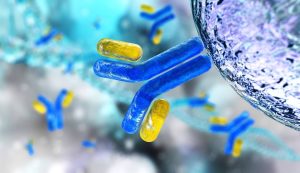The complex interplay of immunoglobulins—IgE, IgG, and IgA—underpins the mechanisms of allergic diseases. These antibodies not only directly regulate allergic reactions but also play a crucial role in inducing immune tolerance through allergen-specific immunotherapy (AIT). IgE drives hypersensitivity, while IgG and IgA act as protective shields, suppressing allergic responses and enhancing immune system tolerance. Advancing the understanding of these antibodies offers promising breakthroughs in managing allergic diseases.

IgE: The “Engine” of Allergic Reactions
Since its discovery in 1967, IgE has been recognized as the central driver of Type I hypersensitivity reactions. Its role begins during the sensitization process, where even minute allergen exposure in susceptible individuals can induce IgE production. This process often occurs early in life, leading to the accumulation of allergen-specific IgE.
Mechanism of Action
IgE exerts its effects by binding to high-affinity receptors (FcεRI) and low-affinity receptors (FcεRII, also known as CD23) on mast cells and basophils. Upon allergen re-exposure, IgE cross-links these receptors, triggering degranulation of mast cells and basophils. This process releases inflammatory mediators such as histamines and leukotrienes, which elicit rapid allergic symptoms.
Beyond its immediate role, IgE amplifies allergic inflammation by facilitating antigen presentation and promoting Th2 cell responses. Through interactions with FcεRI and CD23, IgE induces the production of cytokines like IL-4 and IL-13, perpetuating local inflammation. IgE also extends mast cell survival, contributing to the persistence of chronic allergic diseases.
Structural Features and Stability
The unique structure of IgE, including its four constant regions (Cε1–Cε4), distinguishes it from other antibodies. The Cε2–Cε3 hinge region imparts flexibility, enhancing its binding stability to FcεRI. The resulting IgE-FcεRI complex persists on mast cells for extended periods, a factor linked to the chronic nature of allergic diseases.
Local IgE synthesis in tissues such as nasal mucosa, bronchial epithelium, and gut further amplifies its effects. These tissue-derived IgE molecules interact with local antigen-presenting cells to intensify Th2 immune responses, establishing a comprehensive network that enhances allergic reactions.
IgG and IgA: The “Firewall” Against Allergic Reactions
While IgE acts as a trigger for allergic responses, IgG and IgA serve as key modulators, particularly in the context of allergen-specific immunotherapy (AIT). These antibodies inhibit IgE-mediated reactions by competing for allergen binding, reducing the severity of allergic symptoms, and fostering immune tolerance.
Competitive Blocking and Immune Tolerance
IgG and IgA block allergens by binding to epitopes targeted by IgE, preventing IgE-receptor cross-linking on mast cells and basophils. This competitive binding mitigates degranulation and inflammation. Moreover, passive immunization with allergen-specific IgG or IgA has demonstrated efficacy in reducing allergic symptoms.
Role of IgG4 in AIT
IgG4, a key subclass of IgG induced during AIT, exhibits unique properties that enhance its role as a blocking antibody. IgG4 forms monovalent bispecific antibodies capable of allergen binding without triggering immune complexes or inflammation. Its preferential binding to inhibitory FcγRIIb receptors further suppresses allergic responses.
IgA in Immune Regulation
AIT also induces specific IgA subclasses, including polymeric IgA2, which has been associated with immune tolerance. For example, pollen-specific IgA2 induced during AIT enhances IL-10 production in monocytes, promoting regulatory pathways. IgA’s presence in mucosal secretions, such as nasal fluid, highlights its role in local immune modulation.
Maternal Antibodies: The “Natural Barrier” of Innate Immunity
Maternal IgG and IgA transferred through the placenta and breast milk play an essential role in preventing allergic sensitization in early life. During the third trimester, IgG crosses the placenta, equipping the fetus with passive immunity. Allergen-specific maternal IgG, such as those targeting house dust mites or pollen, has been shown to reduce the offspring’s allergy risk.
Breast milk provides additional protection through IgA. This antibody not only forms a physical barrier in the infant’s gut but also modulates T-cell activation, enhancing immune tolerance. Maternal antibody transfer thus represents a promising avenue for allergy prevention through interventions like maternal vaccination.
Anti-IgE Therapies: A New Era in Allergy Management
Therapies targeting IgE have emerged as transformative tools in allergic disease treatment. Omalizumab, a monoclonal antibody that prevents IgE-FcεRI binding, has proven effective in conditions such as asthma and chronic urticaria.
The next generation of anti-IgE therapies, including ligelizumab, offers an even higher affinity for IgE, showing promise in addressing chronic spontaneous urticaria and other IgE-driven diseases. Combining anti-IgE therapies with AIT may further enhance treatment efficacy by reducing side effects and improving immune tolerance.
The Path Forward: From Prevention to Personalized Therapy
The future of allergy management lies in integrating prevention and personalized therapy. Advancements in understanding the roles of IgE, IgG, and IgA are paving the way for innovative strategies:
- Maternal Immunization: Targeted vaccines during pregnancy could boost allergen-specific IgG and IgA levels, reducing sensitization in offspring.
- Biomarker-Driven AIT: Functional antibody assessments could refine AIT protocols, enabling personalized treatment plans based on individual immune profiles.
- Combination Therapies: Strategies combining AIT, anti-IgE therapies, and IgG or IgA modulation offer synergistic benefits in managing complex allergic conditions.
Conclusion
IgE, IgG, and IgA play distinct yet interconnected roles in allergic diseases, offering critical insights into their mechanisms and therapeutic potential. By advancing research on these antibodies, the medical community can better understand allergic responses and develop innovative interventions. Future breakthroughs, such as maternal immune modulation, IgE-targeted therapies, and tolerance-inducing strategies, hold the promise of transforming allergic disease management, from prevention to highly effective, individualized treatment.

